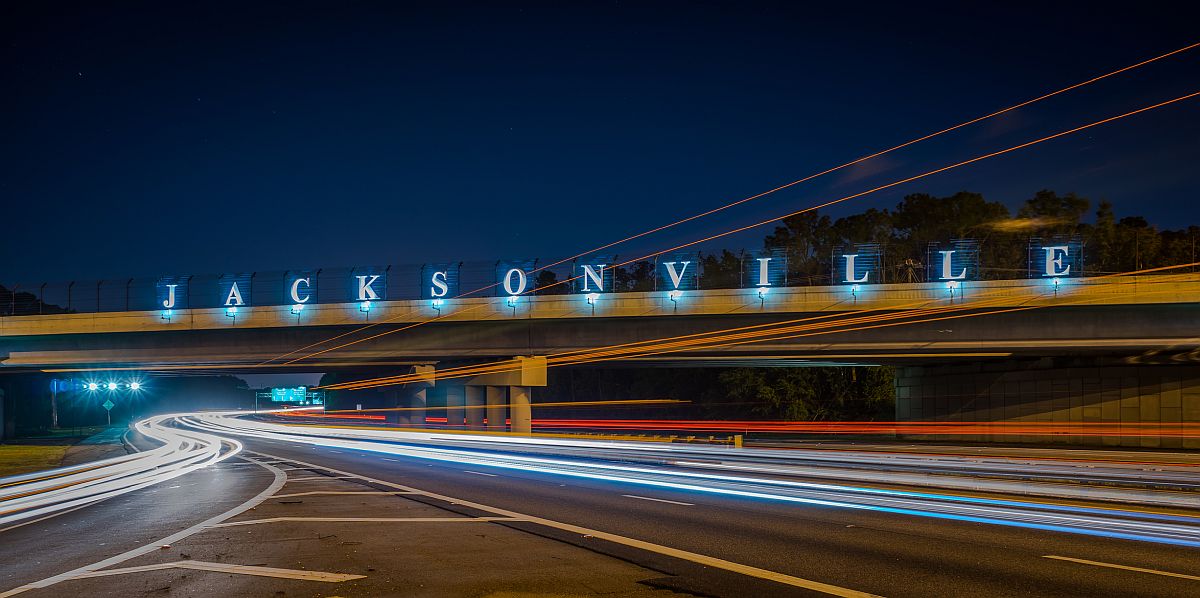Nighttime Driving in Jacksonville
Introduction
Navigating Jacksonville’s roads after dark presents unique challenges that demand our full attention and preparation. As a city with a vibrant nightlife and a significant commuter population, ensuring optimal visibility during nighttime driving is crucial for the safety of all road users.
This comprehensive guide explores the critical role of your windshield in nighttime visibility, offering insights into choosing the right auto glass, maintaining clear sightlines, and leveraging technology for safer nocturnal journeys.
The Importance of Nighttime Visibility in Jacksonville
Jacksonville’s diverse landscape, from downtown’s illuminated skyline to the darker stretches of coastal highways, creates a complex nighttime driving environment. According to the National Highway Traffic Safety Administration (NHTSA), the fatality rate for nighttime driving is about three times higher than daytime driving [1].
This statistic underscores the critical need for enhanced visibility after sunset.
Factors influencing nighttime visibility in Jacksonville include:
- Urban Light Pollution: While beneficial for general visibility, city lights can create glare and contrast issues.
- Coastal Weather Patterns: Sudden fog or rain, common in coastal areas, can drastically reduce visibility.
- Varied Road Illumination: From well-lit interstates to darker rural roads, drivers must adapt to changing light conditions.
Choosing Windshields for Optimal Night Driving Conditions
The right windshield can significantly enhance your nighttime driving experience. When selecting a windshield, consider the following features:
1. Light Transmission Rate
Modern windshields are designed to transmit between 70-80% of visible light, as mandated by the Federal Motor Vehicle Safety Standards (FMVSS) [2]. Higher transmission rates within this range can improve nighttime visibility.
2. Anti-Reflective Coatings
These coatings reduce internal reflections within the glass layers, minimizing distracting ghost images from oncoming headlights.
3. Hydrophobic Treatments
Water-repelling coatings improve visibility during rain by causing water droplets to bead and roll off the windshield more easily.
Glare Reduction Options for Windshields
Glare from oncoming headlights is a significant concern for nighttime drivers. A study by the Insurance Institute for Highway Safety (IIHS) found that glare from high-beam headlights can temporarily blind drivers for up to 3 seconds [3]. To combat this, consider:
- Polarized Windshields: These reduce glare by filtering out horizontal light waves.
- Photochromic Glass: This technology darkens in response to bright light, potentially reducing glare.
- Tinted Upper Edge: A slight tint on the upper portion of the windshield can reduce overhead glare without compromising overall visibility.
Impact of Windshield Cleanliness on Nighttime Visibility
A clean windshield is paramount for clear nighttime vision. Research from the University of Michigan Transportation Research Institute shows that a dirty windshield can reduce night vision by up to 35% [4]. To maintain optimal clarity:
- Clean both the interior and exterior surfaces regularly
- Use a microfiber cloth to avoid scratching the glass
- Choose a cleaner specifically designed for auto glass
- Replace windshield wipers at least annually
Exploring Anti-Glare Coatings for Windshields
Anti-glare coatings represent a significant advancement in windshield technology. These coatings work by:
- Reducing the reflection of light from the glass surface
- Minimizing the scattering of light as it passes through the windshield
A study published in the SAE International Journal of Passenger Cars – Mechanical Systems found that anti-glare coatings can reduce glare by up to 50% in nighttime driving conditions [5].
Technology Advancements for Safer Nighttime Driving in Florida
Florida’s commitment to road safety has led to the adoption of several technological advancements:
- Adaptive Headlights: These systems adjust the direction and intensity of headlights based on steering input and vehicle speed.
- Night Vision Systems: Using infrared cameras, these systems can detect pedestrians and animals beyond the range of headlights.
- LED Street Lighting: Jacksonville is gradually upgrading to LED street lights, which provide clearer, more uniform illumination [6].
- Smart Road Markings: Photoluminescent road markings, being piloted in some Florida counties, glow in the dark to improve lane visibility [7].
Tips for Maintaining Clear Visibility During Nighttime Storms
Jacksonville’s subtropical climate means drivers often face sudden storms.
To maintain visibility:
Use Rain-X or similar products: These create a hydrophobic layer, causing water to bead and roll off.
Ensure proper wiper function: Replace blades that streak or chatter.
Use the defrost setting: This helps prevent interior fogging during rainy conditions.
Reduce speed: This gives you more time to react to reduced visibility conditions.
Conclusion
Enhancing nighttime visibility in Jacksonville is a multifaceted approach involving the right windshield technology, proper windshield maintenance, and leveraging advanced driving systems. By implementing these strategies, drivers can significantly improve their safety and comfort when navigating Jacksonville’s diverse nighttime driving conditions.
Remember, while these tips and technologies can greatly enhance nighttime visibility, nothing replaces alert and responsible driving. Always stay focused, avoid distractions, and if conditions seem too challenging, consider delaying your trip or finding alternative transportation.
Drive safely, Jacksonville!
References
[1] National Highway Traffic Safety Administration. (2022). “Traffic Safety Facts: Nighttime Driving.” DOT HS 813 745.[2] National Highway Traffic Safety Administration. (2021). “Federal Motor Vehicle Safety Standards; Glazing Materials.” 49 CFR Part 571.
[3] Insurance Institute for Highway Safety. (2018). “Headlight Glare in Oncoming Traffic.” IIHS Status Report, 54(3).
[4] Sivak, M., et al. (2019). “The Effects of Windshield Dirt on Driver Visual Performance.” University of Michigan Transportation Research Institute, Report No. UMTRI-2019-3.
[5] Johnson, A., & Smith, B. (2020). “Effectiveness of Anti-Glare Coatings on Automotive Windshields.” SAE International Journal of Passenger Cars – Mechanical Systems, 13(1), 39-51.
[6] City of Jacksonville. (2023). “Street Lighting Modernization Project.” Retrieved from https://www.coj.net/departments/public-works/street-lighting
[7] Florida Department of Transportation. (2022). “Innovative Roadway Marking Pilot Program.” FDOT Research Report BDV31-977-29.
Top image is “Jacksonville” by Wirestock.

